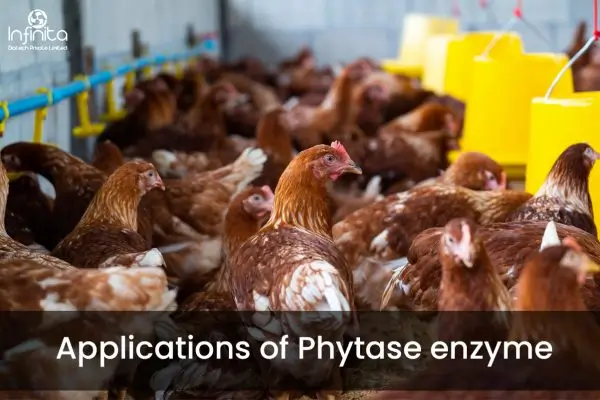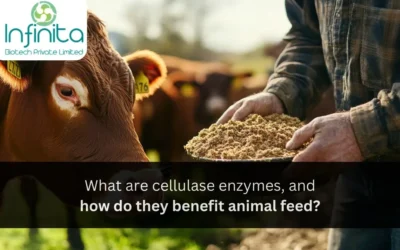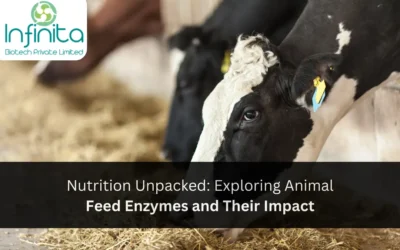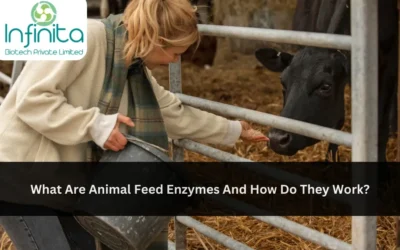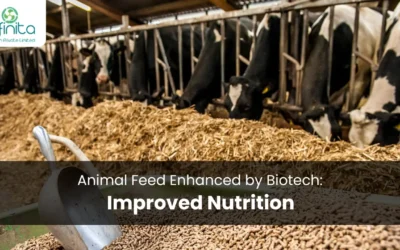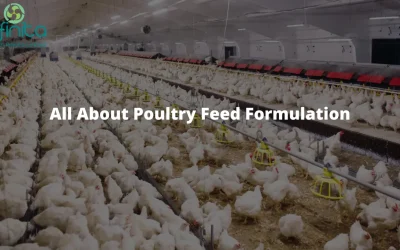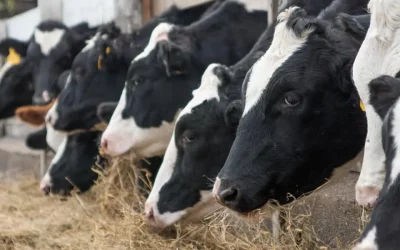Phytase enzyme is an important enzyme with nutrient content for monogastric livestock feed. It breaks down the phospho-monoester linkages present in phytate, a derivative of phytic acid that is the most abundant form of phosphorus (P) in plant cells. Monogastric agricultural animals like poultry and pigs, on the other hand, generate little or no phytase enzyme in their gut. Plant proteins are extensively utilized in chicken diets, and their phytate P is difficult to digest.
Furthermore, by chelating some minerals into the molecule, phytate P lowers their bioavailability. Phytic acid is a naturally occurring anti-nutritional agent, and the smaller the myo-inositol phosphates create complexes with divalent metallic materials. As a result, incorporating phytase enzyme in a mono-gastric feed increases nutritional bioavailability while reducing significant P buildup in manure, which creates environmental difficulties such as water contamination, algae growth, fish mortality, and changes in plant and animal life.
Mechanism Of Action
The phytase enzyme is a protein that catalyzes the conversion of phytate (phytic acid) to inositol and phosphoric acid. The phytase enzyme catalyzes the conversion of the phosphate groups present in the phytic acid one by one to create precursors IP5, IP4, IP3, and IP, with inositol and phosphoric acid as the end products. Various sources of phytase enzymes have various catalytic processes. When 3-phytase works on phytic acid, first it hydrolyzes the ester bond at the 3rd carbon site to liberate inorganic phosphorus, subsequently releasing phosphorus from additional carbon sites one at a time, eventually esterifying the overall phytic acid. The catalytic reaction of this enzyme needs the presence of divalent magnesium ions (Mg2+).
Microorganisms are used to make the new feeding phytase, which is scaled up utilizing bioengineering and recombinant DNA technology. Fungi are commonly used to make phytase. Various microbial fermentation processes, such as submerged, semi-solid state, and solid-state fermentation, are used to create microbial phytases. The method is widely utilized in the fermentation sector, notably for the manufacture of enzymes.
Application of Phytase Enzyme
Phytic acid is an excellent source of carbon, nitrogen, and sulfur that may be converted into a range of chemicals in the natural world. Phytase enzymes have a wide range of industrial, agricultural, and biotechnological uses due to their ability to break down keratins.
Feed Supplements
Phytase enzymes are of excellent importance in biotechnological applications in animal and human nutrition processing and manufacturing because they have the ability to increase phosphorus efficiency and minimize phytate concentration in food and livestock feed.
Monogastric animals, like pigs, poultry, and fish, have no or low amounts of gastrointestinal phytases, preventing them from using the phytate, phosphorus found in food and livestock feed. As a result, they require inorganic phosphate supplementation to satisfy their dietary and growth requirements, which raises feed costs and phosphorus pollution levels. Phytase enzyme is significant in the livestock feed sector because it improves the phosphorus digestive process.
Food Additives
Phytic acid is highly abundant in the grain and wholewheat flour of many types of bread and dough, hence phytases are utilized as a food additive in fermentation processes and in a variety of applications in the production of bread, also feeding additives. The phytase enzyme of A. ficuum, for instance, has been employed in the dephosphorylation of legumes. Up to 78% of phytate was eliminated after combining and incubating soybean meal with fungal phytase for 15 hours.
Plant Growth Promotional Applications
Phosphorus (P) is a key and essential component of cells, and it plays a role in energy metabolism, acid production, and cell membrane biosynthesis. This is also a key macronutrient for plant growth and developmental processes. Soil phosphorus shortage is a big issue for agricultural farmers all over the world. The majority of soils contain considerable levels of total soil P, which may be found in both organic and inorganic forms. Phytic acid is a primary source of biological phosphorus in the soil, accounting for 10 to 50% of available organic phosphorus content. So, the phytase enzyme is essential to digest it.
Therapeutic Applications
Humans use plant-based food items as their primary source of raw component nutrition in many regions of the globe. Plant-based foods are rich in nutrients (carbohydrates, protein, fibre, and vitamins), as well as non-nutrients. Phytate is the most important phosphorus storage molecule in seeds and grains, accounting for up to 90% of overall seed phosphorus. It creates a mineral shortage in humans by forming a complex with dietary elements such as zinc, iron, calcium, magnesium, manganese, and copper.
Other Commercial Phytase Enzyme Products
Phytases are enzymes that are advantageous to animal feeding. They had the major revenue share in the whole industry, accounting for 83.6%. Phytases are added to around 70% of the monogastric animal diet. A. niger provided the very first industrial phytase, which was categorized as a 3-phytase. Peniophora lycii was later used to create an industrial product that was a 6-phytase. For years, a few fungal phytase products are created and commercialized by different firms. Phytase Enzyme is produced on a commercial basis utilizing either phytate-producing fungus or recombinant DNA technologies.
Infinita Biotech is a leading firm that primarily manufactures, distributes, and supplies unique enzyme compounds for a range of industrial manufacturing applications. We are well known for our commercial and eco-sustainable enzymatic solutions.
